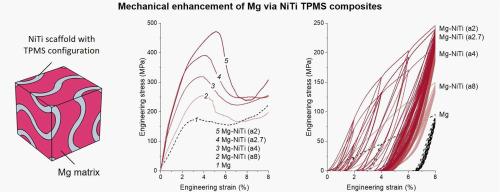Robust and resilient Mg–NiTi interpenetrating-phase composites with triply periodic minimal surface configuration
IF 13.8
1区 材料科学
Q1 METALLURGY & METALLURGICAL ENGINEERING
引用次数: 0
Abstract
Magnesium (Mg)-based materials are promising for lightweight structural applications. However, their widespread adoption is significantly constrained by inherent limitations in mechanical properties. To address this challenge, this study introduces a novel Mg-based interpenetrating-phase composite reinforced with a nickel-titanium (NiTi) scaffold featuring a triply periodic minimal surface (TPMS) configuration. By combining experimental investigations with finite element simulations, we systematically elucidate the dual impact of the scaffold's unit cell size (a) on manufacturing viability and mechanical enhancement. To compensate for compromised infiltration dynamics induced by decreasing a, a critical permeability threshold of 1 × 10−⁸ m² is proposed for achieving successful composite fabrication. Mechanically, reducing a strengthens the interaction between the scaffold and matrix: the TPMS-configured NiTi scaffolds improve stress transfer, deflect crack propagation, and facilitate damage localization, whereas the Mg matrix preserves structural integrity and enables load redistribution. Consequently, the composites significantly outperform pure Mg, and lowering a leads to more substantial enhancements in compressive strength, energy dissipation, and deformation recoverability. This study offers valuable insight into the design and fabrication of high-performance Mg-based materials for structural and biomedical applications.

具有三周期最小表面结构的Mg-NiTi互穿相复合材料
镁基材料在轻量化结构应用方面前景广阔。然而,它们的广泛采用受到机械性能固有限制的极大限制。为了解决这一挑战,本研究引入了一种新型的镁基互穿相复合材料,该复合材料由具有三周期最小表面(TPMS)结构的镍钛(NiTi)支架增强。通过将实验研究与有限元模拟相结合,我们系统地阐明了支架的单元尺寸(a)对制造可行性和机械性能增强的双重影响。为了补偿由于a的降低而导致的渗透动力学受损,我们提出了1 × 10−⁸m²的临界渗透率阈值,以实现成功的复合材料制造。机械上,减少a加强了支架和基体之间的相互作用:tpms配置的NiTi支架改善了应力传递,偏转裂纹扩展,促进了损伤的局部化,而Mg基体保持了结构的完整性,并使载荷重新分配。因此,复合材料的性能明显优于纯Mg,并且降低a会导致抗压强度,能量耗散和变形可恢复性的更显著增强。这项研究为结构和生物医学应用的高性能镁基材料的设计和制造提供了有价值的见解。
本文章由计算机程序翻译,如有差异,请以英文原文为准。
求助全文
约1分钟内获得全文
求助全文
来源期刊

Journal of Magnesium and Alloys
Engineering-Mechanics of Materials
CiteScore
20.20
自引率
14.80%
发文量
52
审稿时长
59 days
期刊介绍:
The Journal of Magnesium and Alloys serves as a global platform for both theoretical and experimental studies in magnesium science and engineering. It welcomes submissions investigating various scientific and engineering factors impacting the metallurgy, processing, microstructure, properties, and applications of magnesium and alloys. The journal covers all aspects of magnesium and alloy research, including raw materials, alloy casting, extrusion and deformation, corrosion and surface treatment, joining and machining, simulation and modeling, microstructure evolution and mechanical properties, new alloy development, magnesium-based composites, bio-materials and energy materials, applications, and recycling.
 求助内容:
求助内容: 应助结果提醒方式:
应助结果提醒方式:


